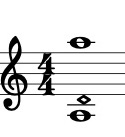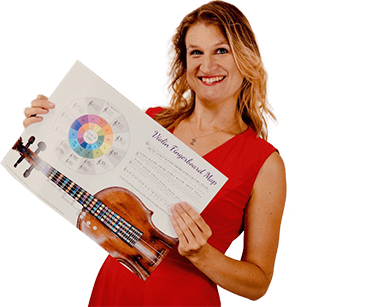Easy Guide to Violin Harmonics
Finally understand and learn how to play ALL possible harmonics on the violin!
Know how they look in sheet music without confusing tables and theories
First the basics: What is a harmonic?
A harmonic is an overtone you get when you place your finger softly on the string. It creates a whistling sound and in some harmonics a different higher note.
What? How is that possible? By not pushing the string down to the fingerboard, the string can vibrate on both sides of your finger.
To end some confusion: in a lot of languages a harmonic is called flageolet
Natural harmonics on the violin
If you place your finger softly on the string in one of the harmonic spots without stopping the string with another finger, this is a natural harmonic. The string vibrates between the nut and your finger tip and between your finger tip and the bridge.
Each string knows 4 natural harmonic notes:
One octave above the open string
On the G string, this would be the G once octave higher, like the one you play with the third finger in the first position on the D string.
Where? This is exactly the middle of the string.
How to play it? You can play this by placing the fourth finger in the fourth position.
You can easily find this one, even if you’re a beginner. Your reference point is the sound box just as it is in the third position. You point your first finger up, stretch your pinky a bit and your second and third finger will be off the string. While your hand rests against the sound box, your fourth finger reaches like a telescope and is placed with the cushion of the finger tip flat on the string.
Two octaves above the open string
On the G string this is the G two octaves higher than the open string, like the one you play with the low second finger in the first position on the E string.
Where? This harmonic is located on a quarter of the string: either counted from the nut or the bridge. The sound is the same.
How to play it? You can play it with the third finger in the first position. When you need to play this and you’re in a high position, you can better go for the version a quarter of the string length from the bridge with whatever finger you find handy.
One octave and a fifth above the open string
On the G string this would be the D, like you play with the third finger in the first position on the A string.
Where? This harmonic is located on a third of the string length: either counted from the nut or the bridge. The sound is the same.
How to play it? You can play it with the fourth finger in the first position and can also play the high version with any finger you want.
Two octaves and a third above the open string
On the G string, this would be the B, like you play with the fourth finger in the first position on the E string.
Where? This harmonic is located on four spots: on a fifth and two fifths from the nut or the bridge.
How to play it? You can find it with the high second finger in the first position or with the third finger in the third position or one of the two same distances from the bridge down.
Overview of the natural harmonics on the violin
Yup, I know I promised you not to bother you with a complicated overview and you don’t need this one. With the information above you can read and find all natural harmonics.
But… stay with me for a moment, because this looks more intimidating that it actually is and I believe you can understand it:
- The lowest note is the string of your violin that you play on.
- The square notes indicate the note you should play with your finger.
- The highest note is the harmonic as it will sound.
- In addition to that if you place your finger on the actual sounding harmonic note, it will sound as well.

Congrats! You’ve learned all natural harmonics on the violin!
Now share the love on Twitter or your favorite platform, so all my hard work doesn’t get to gain dust somewhere on the internet:

Hi! I'm Zlata
Classical violinist helping you overcome technical struggles and play with feeling by improving your bow technique.
Artificial harmonics on the violin
I promise this one will be easy!
If you place your first finger somewhere on the string and you place your fourth finger like you’d play a harmonic… guess what happens? The note will sound two octaves above the first finger you stopped!
Is it really that easy? Yup… it’s the same idea as the natural harmonic with the third finger in the first position I explained above.
Now try playing a harmonic scale…
Haha, not so easy, is it? That’s the difference between theory and practice ;).

How does that look like in sheet music?
In sheet music a harmonic can be written in two ways:
- How it sounds (with a fingering above it indicating a zero)
- How it’s played (see the picture on the right, with the stopped note showing normally and the harmonic note (fourth finger) as a square note. The top note indicates how it sounds (this is something you don’t always see in the sheet music).
Usually composers and editors save you the fuss and write down how to play it and sometimes even how it should sound.
Want to dive deeper in harmonics?
In theory more artificial harmonics are possible, but they are hardly used anywhere, so I’m not covering them in this article. With the principles of the natural harmonics however you can find them yourself. Also it’s possible to play double stops in harmonics.
This article gave you the information to play 99,99% of the harmonics you’ll find in your repertoire
Want to learn more? The nerd in me salutes the nerd in you:
- The book ‘School of harmonics on the violin’ by Richard Scholz (free download)
- The book ‘Lehre der Flageolettöne’ by H. Heller teach you all possible combinations for double stop harmonics.
- Like to practice your harmonics including double stop harmonic scales? Find them inside the Scale System by Flesch.
- This website is very handy for composers as it gives you a complete overview of harmonics on the violin.
- This overview looks a bit like mine, but can be useful as well, also you can play the sound of the notes.
- Here’s a scientific article in case you want to spend a rainy Sunday afternoon exploring the more scientific side of this topic.


I like harmonics but very hard.
The easiest is the open string with 3rd finger. But i still want to try more.
Sure, happy practicing!
Oh my dear Zlata you never cease to educate me… and all this time I thought a flageolate was an old mid-east instrument… ha ha. But I really appreciate your clear and concise treatment of harmonics. Having a background in vibrations engineering I understand the theory behind them and can even write the math equations for them, but playing them is a different matter. You have cleared up much of the mystery about them, especially in showing us where to put the fingers to get harmonics other than the obvious octave. Teaching us to “read” the music that uses them is especially valuable and clarifies many things that are not clear in some of the methods. Now working out a G major scale using just harmonics seems like a possible and interesting challenge. Time to see if your bowing help will get me to play them well. Please keep yourself and family safe and healthy in this disturbing pandemic we are all surrounded by.
hahaha, maybe a flageolet is an instrument, who knows! Glad this was helpful and interesting. Stay safe and healthy! All the best, Zlata
Thank you for making this so clear. I have seen the last chart at least 2 dozen times and I could never understand it was or what it was supposed to mean. Thank you for sharing with us!
I’m glad it’s helpful, David!
Thank you very much, this is so kind of you to share!
Glad it’s helpful, Helen!
Thank you so much this is so clear! I love this chart / guide.
Glad it’s helpful!
Thank you. very helpful
I’m happy it is!
Can harmonics be made with no fingers at all, on open strings, maybe by just bowing lightly?? I recently came across a harmonic symbol in my Strictly Strings Book 2, on page 21, exercise number 4. It has a harmonic symbol above the open G string, no other notation is given. It’s a great mystery to me. Could you explain that type of harmonic?
When you see a zero above the note, it indicates that you should play an harmonic. You can use the third or fourth finger for that depending on what’s most handy. And yes, flautato is a bow technique, but I doubt if that’s what’s meant in the repertoire you mentioned.
Wonderful! for the first time, I get a clear, concise and complete explanation of the fundamentals of harmonics in a way I can relate to. Thanks so very much!
Happy you appreciate!
Doyou have etude for triple or quadrupple stops?
A good one for triple stops is Dont no 1. There aren’t really etudes for quadrupple stops or do you mean chords?
This is a brilliant guide to harmonics. Really excellent!
I was looking at the harmonics in the Wieniawski Scherzo Tarantelle. They’re terrible! Right at the end there seems to be a fingered harmonic that is part of a chord!
Glad it’s helpful 🙂